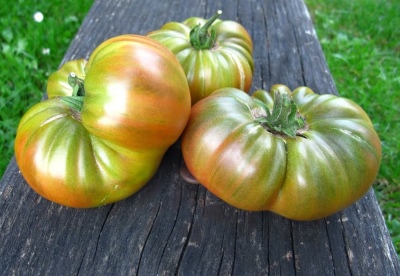
- Authors: Lynn Brown, USA (Napa, CA)
- Name synonyms: Copper River, Cooper River
- Category: grade
- Growth type: indeterminate
- Appointment: fresh consumption
- Ripening period: mid-season
- Ripening time, days: 100-110
- Growing conditions: for open ground, for greenhouses
- Bush size: medium-sized
- Bush height, cm: 150-180
This rare tomato variety will be a godsend for exotic lovers. Copper River is a California novelty of beautiful tricolor (even multicolor) tomatoes. This variety can attract a lot - gigantic size, amazing and unique color, and the taste is as if it were a delicacy.
Breeding history
The originator of the variety is Lynn Brown, an American breeder from California. In our country, this tomato is a rarity, therefore it deserves special attention. Its other names are Copper River, Cooper River.
Description of the variety
The variety is semi-determinant, sometimes it is referred to as indeterminate. In any case, this is a medium-sized bush. The height varies depending on the place of growth: in the greenhouse it can reach 1.5-1.8 m, while in the beds, in the open air it grows no more than 80 cm.Like any other variety, the Copper River has its pros and cons. Let's start with the benefits:
- large fruits;
- resistance to most diseases;
- endurance.
Of the shortcomings, the impossibility of whole-fruit canning is indicated. However, many people try to make blanks by cutting the tomato into slices.
The main qualities of the fruit
The main difference between the Copper River tomato and other varieties is, of course, its color. It is even difficult to describe it. Here is a whole mix of colors, including bronze, light green, dark yellow, pink erosion, and after full ripening it becomes emerald brown. The skin is strong, not prone to cracking. By their mass, the fruits are large, from 200 grams to half a kilogram.
Taste characteristics
The taste of the Copper River is another feature of this variety. The pulp, which, however, is also multi-colored (pink, light yellow, even red blotches on a green background), not only sweetish, with a fruity flavor, but also very tender, oily, literally melts in your mouth. When sliced, the vegetable looks great; it can decorate any festive feast. Mainly intended for salads and juices.
Ripening and fruiting
The ripening time of the Copper River is average. So, fruiting will take place 100-110 days after germination.
Yield
The variety is considered quite fruitful, because from each square meter of planting, you can remove from 7 to 9 kilograms of amazing fruits.
The timing of planting seedlings and planting in the ground
The American variety is grown in a traditional seedling way. The final planting of grown seedlings occurs when 50-60 days have passed after sowing the seeds. The timing in each case is chosen by the gardener himself, depending on the region and climatic conditions.

Growing tomato seedlings is an extremely important process, because it largely depends on whether the gardener can harvest at all. All aspects must be taken into account, from seedbed preparation to planting in the ground.
Landing scheme
Given the size of the variety's bushes, 4-5 plants of the Copper River are most often located on one square.

Growing and care
Although the culture came to us from America, it is worth caring for it the same way as for any other. Tomatoes of the Copper River are formed into 2-3 trunks. Plants need to be watered twice a week. They are fed during the flowering period, as well as when ripe.
The American cultivar is very picky about soil nutrition. This issue should be given special attention. If grown where the summer can be very cool, the bushes will even need shelter. However, this is rather an exception to the rule, mainly the variety is distinguished by cold resistance and drought resistance. It can bear fruit stably under any changes in weather and temperature. At the same time, the plant has a fairly good resistance to fruit cracking and a high yield.




A plant needs different micronutrients at each stage of growth. All fertilizers can be divided into two groups: mineral and organic. Folk remedies are often used: iodine, yeast, bird droppings, eggshells.
It is important to observe the rate and period of feeding. This also applies to folk remedies and organic fertilizers.


Growing regions
American Tomato Copper River can be grown in various regions of Russia.

























































































